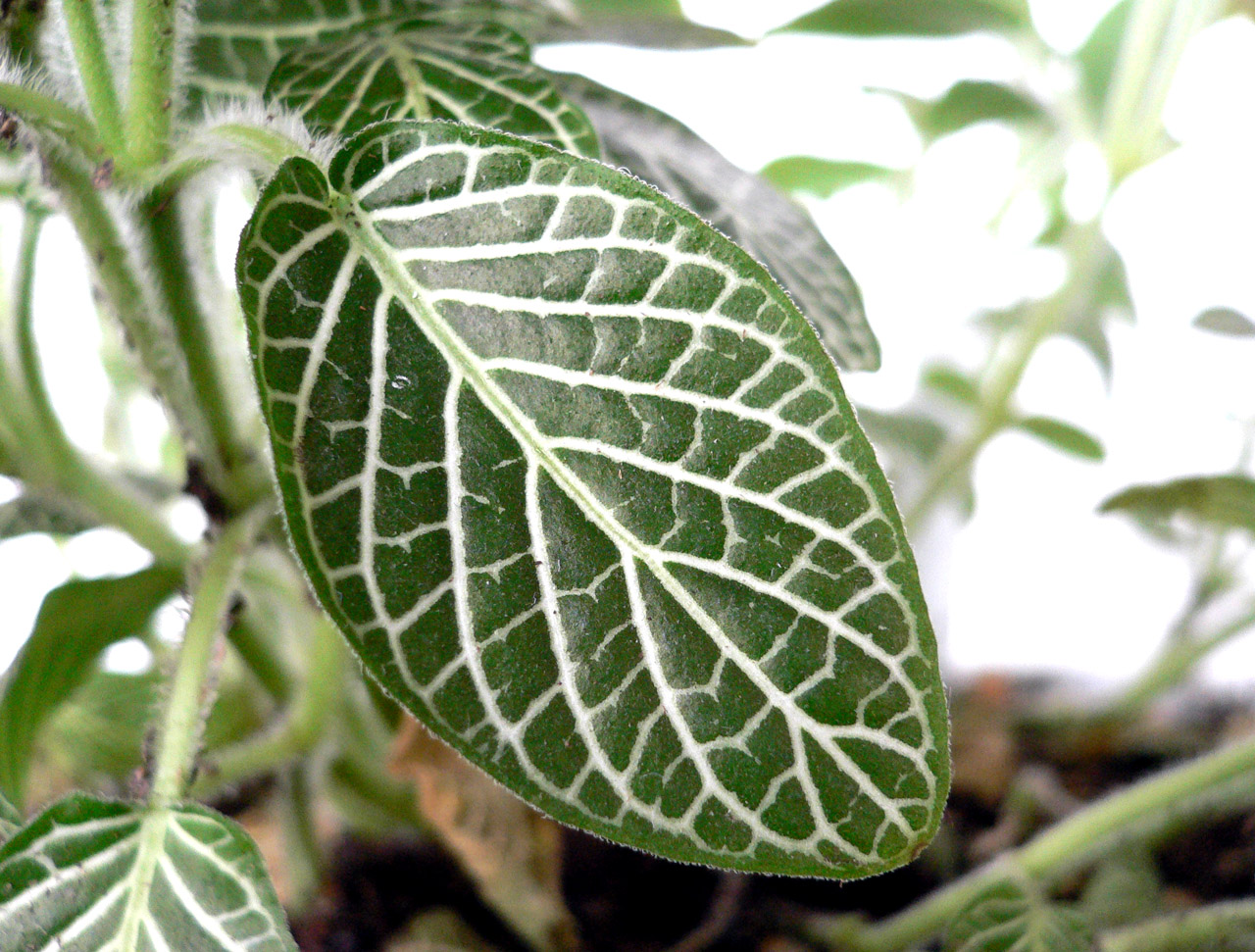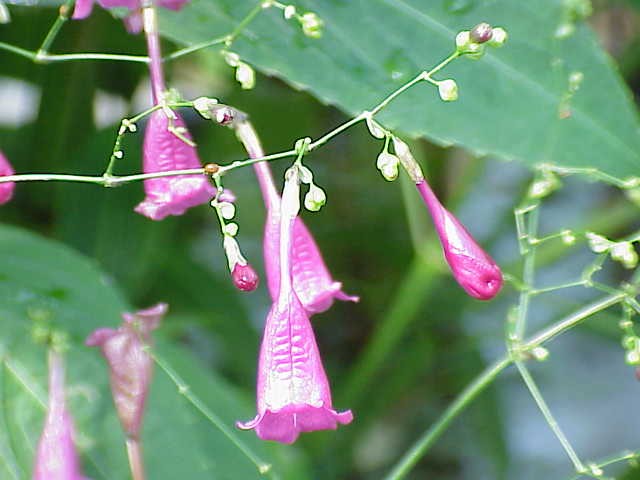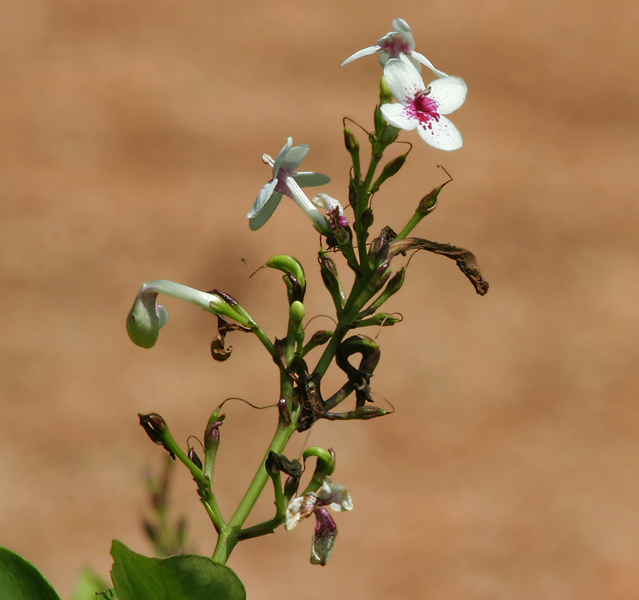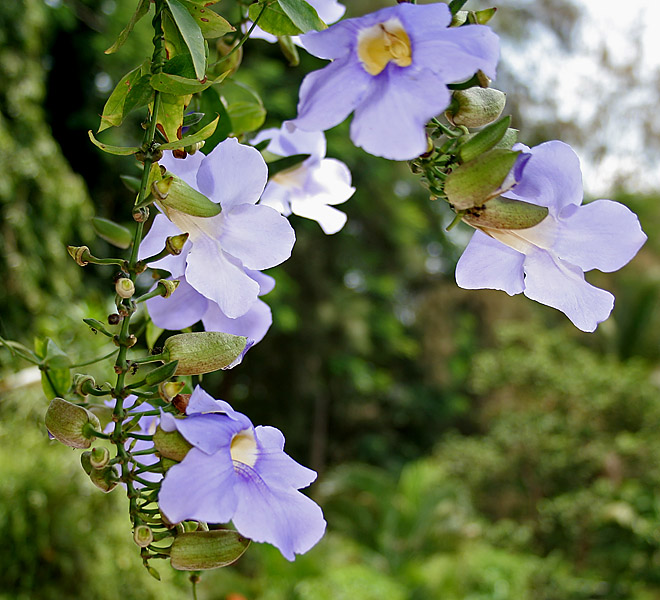Acanthaceæ on:
[Wikipedia]
[Google]
[Amazon]
Acanthaceae is a family (the acanthus family) of










 , the Germplasm Resources Information Network accepts 217 genera, while 206 accepted genera are listed by
, the Germplasm Resources Information Network accepts 217 genera, while 206 accepted genera are listed by
Tree of Life Acanthaceae
Flowers in Israel.
i
{{Taxonbar, from=Q53475 Lamiales families
dicotyledon
The dicotyledons, also known as dicots (or, more rarely, dicotyls), are one of the two groups into which all the flowering plants (angiosperms) were formerly divided. The name refers to one of the typical characteristics of the group: namely, t ...
ous flowering plants containing almost 250 genera and about 2500 species. Most are tropical herbs
In general use, herbs are a widely distributed and widespread group of plants, excluding vegetables and other plants consumed for macronutrients, with savory or aromatic properties that are used for flavoring and garnishing food, for medicinal ...
, shrub
A shrub (often also called a bush) is a small-to-medium-sized perennial woody plant. Unlike herbaceous plants, shrubs have persistent woody stems above the ground. Shrubs can be either deciduous or evergreen. They are distinguished from trees ...
s, or twining vines; some are epiphytes. Only a few species are distributed in temperate regions. The four main centres of distribution are Indonesia and Malaysia, Africa, Brazil, and Central America. Representatives of the family can be found in nearly every habitat, including dense or open forests, scrubland
Shrubland, scrubland, scrub, brush, or bush is a plant community characterized by vegetation dominance (ecology), dominated by shrubs, often also including grasses, Herbaceous plant, herbs, and geophytes. Shrubland may either occur naturally or ...
s, wet fields and valleys, sea coast and marine areas, swamp
A swamp is a forested wetland.Keddy, P.A. 2010. Wetland Ecology: Principles and Conservation (2nd edition). Cambridge University Press, Cambridge, UK. 497 p. Swamps are considered to be transition zones because both land and water play a role in ...
s, and mangrove forests.
Description
Plants in this family have simple, opposite,decussate
Decussation is used in biological contexts to describe a crossing (due to the shape of the Roman numeral for ten, an uppercase 'X' (), ). In Latin anatomical terms, the form is used, e.g. .
Similarly, the anatomical term chiasma is named aft ...
d leaves
A leaf (plural, : leaves) is any of the principal appendages of a vascular plant plant stem, stem, usually borne laterally aboveground and specialized for photosynthesis. Leaves are collectively called foliage, as in "autumn foliage", wh ...
with entire (or sometimes toothed, lobed, or spiny) margins, and without stipules. The leaves may contain cystoliths, calcium carbonate concretions, seen as streaks on the surface.
The flowers are perfect, zygomorphic to nearly actinomorphic, and arranged in an inflorescence that is either a spike, raceme
A raceme ( or ) or racemoid is an unbranched, indeterminate type of inflorescence bearing flowers having short floral stalks along the shoots that bear the flowers. The oldest flowers grow close to the base and new flowers are produced as the s ...
, or cyme. Typically, a colorful bract
In botany, a bract is a modified or specialized leaf, especially one associated with a reproductive structure such as a flower, inflorescence axis or cone scale. Bracts are usually different from foliage leaves. They may be smaller, larger, or of ...
subtends each flower; in some species, the bract is large and showy. The calyx
Calyx or calyce (plural "calyces"), from the Latin ''calix'' which itself comes from the Ancient Greek ''κάλυξ'' (''kálux'') meaning "husk" or "pod", may refer to:
Biology
* Calyx (anatomy), collective name for several cup-like structures ...
usually has four or five lobes; the corolla
Corolla may refer to:
*Corolla (botany), the petals of a flower, considered as a unit
*Toyota Corolla, an automobile model name
* Corolla (headgear), an ancient headdress in the form of a circlet or crown
* ''Corolla'' (gastropod), a genus of moll ...
tubular, two-lipped or five-lobed; stamen
The stamen (plural ''stamina'' or ''stamens'') is the pollen-producing reproductive organ of a flower. Collectively the stamens form the androecium., p. 10
Morphology and terminology
A stamen typically consists of a stalk called the filame ...
s number either two or four, arranged in pairs and inserted on the corolla, and the ovary
The ovary is an organ in the female reproductive system that produces an ovum. When released, this travels down the fallopian tube into the uterus, where it may become fertilized by a sperm. There is an ovary () found on each side of the body. ...
is superior and bicarpellated, with axile placentation.
The fruit is a two-celled capsule, dehiscing somewhat explosively. In most species, the seeds are attached to a small, hooked stalk (a modified funiculus called a jaculator or a retinaculum) that ejects them from the capsule. This trait is shared by all members of the clade Acanthoideae. A 1995 study of seed expulsion in Acanthaceae used high speed video pictures to show that retinacula propel seeds away from the parent plant when the fruits dehisce, thereby helping the plant gain maximum seed dispersal range.
A species well known to temperate gardeners is bear's breeches ('' Acanthus mollis''), a herbaceous perennial plant with big leaves and flower spikes up to 2 m tall. Tropical genera familiar to gardeners include '' Thunbergia'' and '' Justicia''.
'' Avicennia'', a genus of mangrove trees, usually placed in Verbenaceae or in its own family, Avicenniaceae
''Avicennia'' is a genus of flowering plants currently placed in the bear's breeches family, Acanthaceae. It contains mangrove trees, which occur in the intertidal zones of estuarine areas and are characterized by its "pencil roots", which are ...
, is included in Acanthaceae by the Angiosperm Phylogeny Group on the basis of molecular phylogenetic
Molecular phylogenetics () is the branch of phylogeny that analyzes genetic, hereditary molecular differences, predominantly in DNA sequences, to gain information on an organism's evolutionary relationships. From these analyses, it is possible to ...
studies that show it to be associated with this family.
Medicinal uses
Traditionally the most important part use in Acanthaceae is the leaves and they are used externally for wounds. Some research has indicated that Acanthaceae possessantifungal
An antifungal medication, also known as an antimycotic medication, is a pharmaceutical fungicide or fungistatic used to treat and prevent mycosis such as athlete's foot, ringworm, candidiasis (thrush), serious systemic infections such as crypto ...
, cytotoxic
Cytotoxicity is the quality of being toxic to cells. Examples of toxic agents are an immune cell or some types of venom, e.g. from the puff adder (''Bitis arietans'') or brown recluse spider (''Loxosceles reclusa'').
Cell physiology
Treating cells ...
, anti-inflammatory, anti-pyretic
An antipyretic (, from ''anti-'' 'against' and ' 'feverish') is a substance that reduces fever. Antipyretics cause the hypothalamus to override a prostaglandin-induced increase in temperature. The body then works to lower the temperature, which r ...
, antioxidant
Antioxidants are compounds that inhibit oxidation, a chemical reaction that can produce free radicals. This can lead to polymerization and other chain reactions. They are frequently added to industrial products, such as fuels and lubricant ...
, insecticidal, hepatoprotective
Hepatoprotection or antihepatotoxicity is the ability of a chemical substance to prevent damage to the liver. This is opposite to hepatotoxicity.
Hepatoprotective molecules used in emergency medicine
* Acetylcysteine is considered the hepatopro ...
, immunomodulatory, anti-platelet aggregation and anti-viral potential
Antiviral drugs are a class of medication used for treating viral infections. Most antivirals target specific viruses, while a broad-spectrum antiviral is effective against a wide range of viruses. Unlike most antibiotics, antiviral drugs do ...
.
For instance, ''Acanthus ilicifolius
''Acanthus ilicifolius'', commonly known as holly-leaved acanthus, sea holly, and holy mangrove is a species of shrubs or herbs, of the plant family Acanthaceae, native to Australia, Australasia, and Southeast Asia. It is used as medicine in asth ...
'', whose chemical composition has been heavily researched, is widely used in ethnopharmaceutical applications, including in Indian and Chinese traditional medicine. Various parts of ''Acanthus ilicifolius'' have been used to treat asthma, diabetes, leprosy, hepatitis, snake bites
A snakebite is an injury caused by the bite of a snake, especially a venomous snake. A common sign of a bite from a venomous snake is the presence of two puncture wounds from the animal's fangs. Sometimes venom injection from the bite may occu ...
, and rheumatoid arthritis. The leaves of '' Acanthus ebracteatus'', noted for their antioxidant
Antioxidants are compounds that inhibit oxidation, a chemical reaction that can produce free radicals. This can lead to polymerization and other chain reactions. They are frequently added to industrial products, such as fuels and lubricant ...
properties, are used for making Thai herbal tea in Thailand and Indonesia.
Phytochemistry
Phytochemical reports on family Acanthaceae areglycosides
In chemistry, a glycoside is a molecule in which a sugar is bound to another functional group via a glycosidic bond. Glycosides play numerous important roles in living organisms. Many plants store chemicals in the form of inactive glycosides. ...
, flavonoids, benzonoids, phenolic compounds
In organic chemistry, phenols, sometimes called phenolics, are a class of chemical compounds consisting of one or more hydroxyl groups (— O H) bonded directly to an aromatic hydrocarbon group. The simplest is phenol, . Phenolic compounds are c ...
, naphthoquinone and triterpenoids.
Overview of systematics
Since the first comprehensive classification of Acanthaceae in 1847 by Nees, there have been a few major revisions presented since for the whole family. Lindau, in 1895, divided the family into the subfamilies Mendoncioideae, Thunbergioideae, Nelsonioideae, and Acanthoideae. Critically, Mendoncioideae, Thunbergioideae, and Nelsonioideae do not possess retinaculate fruits—and it is this distinction, between classifying Acanthaceae into a family that includes those clades with non-retinaculate fruits and one that excludes them, that still persists to the modern day. Bremekamp, in 1965, presented a classification of Acanthaceae that differed from that of Lindau, for his Acanthaceae excluded genera that lack retinaculate fruits. He placed Nelsonioideae within Scrophulariaceae, classified Thunbergiaceae and Mendonciaceae as distinct families and divided his Acanthaceae into two groups (Acanthoideae and Ruelloideae) based on the presence or absence of cystoliths, articulate stems, monothecateanthers
The stamen (plural ''stamina'' or ''stamens'') is the pollen-producing reproductive organ of a flower. Collectively the stamens form the androecium., p. 10
Morphology and terminology
A stamen typically consists of a stalk called the filam ...
, and colpate pollen
Pollen is a powdery substance produced by seed plants. It consists of pollen grains (highly reduced microgametophytes), which produce male gametes (sperm cells). Pollen grains have a hard coat made of sporopollenin that protects the gametophyt ...
.
In Scotland and Vollesen's 2000 study, they accepted 221 genera
Genus ( plural genera ) is a taxonomic rank used in the biological classification of living and fossil organisms as well as viruses. In the hierarchy of biological classification, genus comes above species and below family. In binomial nomenclat ...
and detailed five major groups within Acanthaceae s.s. (that is, those possessing retinaculate fruits), which is equivalent to Acanthoideae Link sensu Lindau 1895. Out of those 221 genera, they placed 201 of them into seven infrafamilial taxa of Acanthaceae, leaving only 20 unplaced.
In the current understanding of Acanthaceae, Acanthaceae s.s.
The ''Schutzstaffel'' (SS; also stylized as ''ᛋᛋ'' with Armanen runes; ; "Protection Squadron") was a major paramilitary organization under Adolf Hitler and the Nazi Party in Nazi Germany, and later throughout German-occupied Europe duri ...
includes only those clade
A clade (), also known as a monophyletic group or natural group, is a group of organisms that are monophyletic – that is, composed of a common ancestor and all its lineal descendants – on a phylogenetic tree. Rather than the English term, ...
s with retinaculate fruits (that is, Acantheae, Barlerieae, Andrographideae, Whitfieldeae, Ruellieae
Acanthoideae is a subfamily of plants in the family Acanthaceae.
Tribes and genera
Wikispecies lists the following genera in six tribes: Acantheae
* ''Acanthopsis''
* '' Acanthus''
* '' Achyrocalyx''
* '' Aphelandra''
* '' Blepharis''
* ''Crossa ...
, and Justiceae), while Acanthaceae s.l.
SL may refer to:
Arts and entertainment
* SL (rapper), a rapper from London
* ''Second Life'', a multi-user 3D virtual world
* Sensei's Library, an Internet site dedicated to the game of Go
* Subdominant leittonwechselklänge
* Leica SL, a mirror ...
includes those clades as well as Thunbergioideae, Nelsonioideae, and '' Avicennia.''
Dating the Acanthaceae lineage
Much research, using both molecular data and fossils, has been conducted in recent years regarding the dating and distribution of the Acanthaceae and Lamiales lineage, although there still remains some ambiguity. In a 2004 study on the molecular phylogenetic dating of asterid flowering plants, researchers estimated 106 million years (MY) for the stem lineage of Lamiales, 67 MY for the stem lineage of Acanthaceae, and 54 MY for the crown node of Acanthaceae (that is, the age of extant lineages with the family). These estimates are older than those based on fossils that can confidently be assigned to Lamiales, which are middle Eocene in age, ca. 48-37 MY. Palynomorphs that definitively show the existence of Acanthaceae are known from the upper Miocene, with the oldest ca. 22 MY.Selected genera









 , the Germplasm Resources Information Network accepts 217 genera, while 206 accepted genera are listed by
, the Germplasm Resources Information Network accepts 217 genera, while 206 accepted genera are listed by Plants of the World Online
Plants of the World Online (POWO) is an online database published by the Royal Botanic Gardens, Kew. It was launched in March 2017 with the ultimate aim being "to enable users to access information on all the world's known seed-bearing plants by ...
(the Royal Botanic Gardens, Kew).
Excluded genera
* ''Thomandersia
''Thomandersia'' is the sole genus in the Thomandersiaceae, an African family of flowering plants. ''Thomandersia'' is a genus of shrubs and small trees, with six species native to Central and West Africa.
''Thomandersia'' traditionally has been ...
'' Baill. → Thomandersia
''Thomandersia'' is the sole genus in the Thomandersiaceae, an African family of flowering plants. ''Thomandersia'' is a genus of shrubs and small trees, with six species native to Central and West Africa.
''Thomandersia'' traditionally has been ...
ceae
References
*External links
Tree of Life Acanthaceae
Flowers in Israel.
i
{{Taxonbar, from=Q53475 Lamiales families